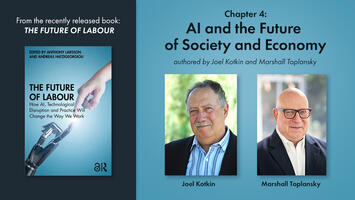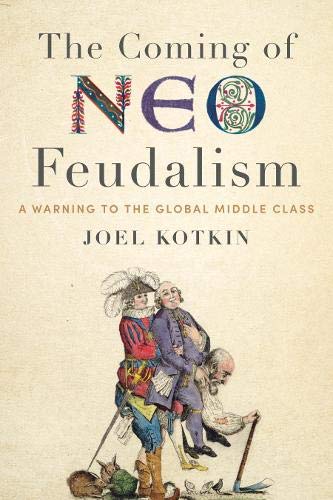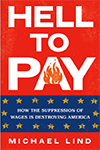
The recently released book, The Future of Labor, is an anthology that offers an exploration of how artificial intelligence (AI), digitalisation and technological transformation are reshaping the future of work. The first section of Chapter 4 — authored by Joel Kotkin and Marshall Toplansky — is excerpted below.
4.1 Section One: AI and the Evolution of Business
Artificial Intelligence (AI) is perhaps the most widely discussed new technology in history. Forecasts of its future range from imminent societal collapse to the spawning of a new paradigm for economic organisation. Some two-thirds of Americans fear its rise and roughly three in five, according to a 2023 poll, see it as a direct threat to civilisation (Edwards, 2023; Tong, 2023). World Economic Forum chairman Klaus Schwab warns about humans losing control of the world during the Fourth Industrial Revolution (Newcomb, 2023).
The business appeal of AI is obvious. AI is about improving the accuracy of decision-making by harnessing past experience to predict the future. It is not about creating new sentient, infallible life forms like “Ultron” from Marvel Comics or “Lt. Commander Data” from Star Trek. It is about eliminating mankind’s natural stupidity that comes from making the same mistakes over and over again without learning from the past. PricewaterhouseCoopers (PwC) estimated AI technologies would add US$15.7 trillion to the global economy by 2030. McKinsey & Company estimates generative AI alone will add US$4.4 trillion annually to the global economy (Chui et al., 2023; Goldman, 2023; PwC, 2017).
Entrepreneurs and innovators may seek to disrupt existing order, but most businesses are built around optimising existing systems. Build the same thing cheaper so you make more money than your competitors. Define target audiences more precisely so you can reach them more efficiently and effectively. Identify friction points in processes so you can smooth them out and make things happen faster and more easily. This is the ongoing struggle of businesses and markets since the beginning of capitalism.
Historically, humans have performed these analytical tasks manually. They created tools, like spreadsheets and surveys to help them. However, the task of optimising businesses has largely been the province of human analysts. This is where AI steps in. Its focus is on speeding up the time for collecting, analysing and forecasting by orders of magnitude in ways beyond the capability of human analysts in a timely manner. To put the speed gap into perspective, a study conducted by Stanford University compared the performance of AI algorithms against human radiologists in detecting breast cancer from mammograms. The AI algorithm achieved a 94.5% accuracy rate, outperforming the human radiologists who achieved an accuracy rate of 88.1%. Furthermore, the AI algorithm took an average of just 2.5 seconds to analyse each image, while the radiologists took an average of 11.8 seconds, and the AI algorithm can work 24 hours/day, 365 days/year without resting (Bakar, 2024).
AI finds patterns in the flow that accurately predict the observed behaviour of a business or of a consumer or of a market. Those patterns may be very counter-intuitive to the “conventional wisdom” that has been built up over time around an industry. However, they may be far more accurate in their predictive power. The economic value of being able to predict outcomes accurately outweighs the comfort of understanding the root causes that go into a prediction. Moreover, since the world does not stand still and is in continual motion, being able to accurately automate the prediction process has even greater economic value.
The underlying premise of AI is that machines can learn to detect patterns and changes in those patterns better than human beings can. Typically, the machine learning process starts with humans “teaching” computers what they know. Humans define the rules for the machine. “Here is what winning is”, or “Here is what we define as a desired outcome”. AI technology has progressed to the point that machines take over the responsibility of learning how to identify patterns accurately on their own. They create their own internal competition to test which patterns are more accurate in predicting things (Rouse, 2023).
At this early stage of AI, computers are prioritising predicting relevance, not factual accuracy. In ChatGPT or Google Gemini (originally known as “Google Bard”), for instance, computers learn by competing with each other to accurately predict what YOU are looking for, based on your prompt. You may ask a question like, “Is global warming happening and why?” The answer you get back reflects what the AI thinks you are asking about and feeds you back what has been published in the world on that topic, organised in a way it thinks you will find useful. It has based its submission to you on what other people have asked about that same topic. You then tell ChatGPT or Google Gemini whether the answer is satisfactory. Or you may then ask the question in another way. The AI learns from how you phrase things to refine the answer in a way that is more satisfying.
At this stage in AI, it is NOT actually concerned with the underlying accuracy of the answer. It is “crowd sourcing” its answers. This “group think” can have its obvious dangers. However, if you believe that people generally act as a herd and follow what most other people do or say, the power of AI to reduce the volatility of humans and their markets may be compelling to businesses that are NOT looking to disrupt existing behaviour patterns.
Ultimately AI works off the surveillance of people and ideas. Its key is mass observation of human and machine behaviour on a continual basis. The notion that we are all being constantly surveilled is understandably repugnant to a large swath of society, which was reared on the notion that their privacy and individuality is sacrosanct. Unfortunately, like it or not, privacy is largely an illusion today. Virtually everything anyone does is tracked and recorded for the computers that then add their behaviour to the vast stew of AI databases. The younger generation’s acceptance of and fascination with social media systems, fuelled and funded through mass surveillance, indicate to us that humans seem willing to make the trade-off of their privacy for some economic advantage. Unions are already raising concerns about how AI could help bosses keep close watch on their employees, even outside their jobs (Tracy, 2023).
For better or worse, AI is just in its infancy. There are already experiments to see how it can be enhanced with human brain cells (Blain, 2023). It is also not simply one thing. AI comprises a wide range of technologies and use cases. From the large language and generative AI models like ChatGPT, Google Gemini and Dall-E, they are the equivalent of the first automobiles: fun to play with, somewhat unreliable and maybe a little dangerous. But over time, the lesson for companies, notes Rich Karlgaard (2023, para. 4), will be clear: Who Learns Fastest, Wins.
Buy the book at Routledge.
Joel Kotkin is the author of The Coming of Neo-Feudalism: A Warning to the Global Middle Class. He is the Roger Hobbs Presidential Fellow in Urban Futures at Chapman University and and directs the Center for Demographics and Policy there. He is Senior Research Fellow at the Civitas Institute at the University of Texas in Austin. Learn more at joelkotkin.com and follow him on Twitter @joelkotkin.
Marshall Toplansky is an award-winning Innovation Professor of Management Science at the Argyros School of Business and Economics at Chapman University. He is a widely published and award-winning marketing professional and successful entrepreneur. Marshall co-founded KPMG's data & analytics center of excellence and now teaches and consults corporations on their analytics strategies.
Notes:
- Edwards, B. (2023). Poll: AI Poses Risk to Humanity, According to Majority of Americans. Retrieved March 6, 2025, from Ars Technica website. (back to reference)
- Tong, A. (2023). AI Threatens Humanity’s Future, 61% of Americans Say: Reuters/Ipsos Poll. Retrieved March 6, 2025, from Reuters website. (back to reference)
- Larsson, A., & Hatzigeorgiou, A. (Eds.). (2025). The Future of Labour: How AI, Technological Disruption and Practice Will Change the Way We Work (1st ed.). Routledge. doi.org/. (back to reference)
- Chui, M., Hazan, E., Roberts, R., Singla, A., Smaje, K., Sukharevsky, A., … Zemmel, R. (2023). The Economic Potential of Generative AI: The Next Productivity Frontier. Retrieved March 6, 2025, from McKinsey Digital website.(back to reference)
- Goldman, D. P. (2023). Why AI Can’t Think. Retrieved March 6, 2025, from Law & Liberty website. (back to reference)
- PwC. (2017). Sizing the Prize. Retrieved March 6, 2025, from PwC website. (back to reference)
- Rouse, M. (2023). Generative Adversarial Network. Retrieved March 6, 2025, from Technopedia website. (back to reference)
- Tracy, R. (2023). Business and Labor Square Off Over AI’s Future in American Workplace. Retrieved March 6, 2025, from The Wall Street Journal website. (back to reference)
- Blain, L. (2023). Computer Chip With Built-In Human Brain Tissue Gets Military Funding. Retrieved March 6, 2025, from New Atlas website. (back to reference)
- Karlgaard, R. (2023). Who Learns Fastest, Wins. Retrieved March 6, 2025, from Forbes website. (back to reference)












